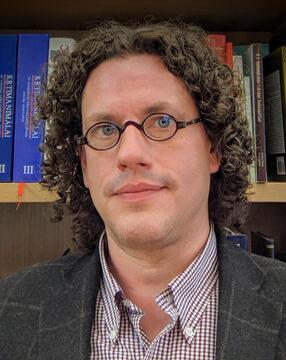Ian Quinn
About: Ian Quinn holds degrees from Columbia University (B.A., 1993) and the Eastman School of Music of the University of Rochester (M.A., 1998; Ph.D., 2004). Before joining the Yale faculty, he taught at the University of Chicago and the University of Oregon. In 2008-09 he was a Residential Fellow of the Center for Advanced Study in the Behavioral Sciences (CASBS) at Stanford.
Quinn edited the Journal of Music Theory from 2004 to 2011 and serves on the editorial board of the Journal of Mathematics and Music, which launched in 2007. He was co-organizer (with Richard Cohn) of the 2009 meeting of the Society for Mathematics and Computation in Music. He serves on the executive committee of the Northeast Music Cognition Group (NEMCOG), which meets several times per year in New York, New Haven, and Boston. He also organizes the Yale-New Haven Regular Singing (YNHRS), a weekly shape-note singing group.
His publications have twice won awards from the Society for Music Theory: the Emerging Scholar Award in 2004 for “Listening to Similarity Relations,” Perspectives of New Music 39/2 (2001), and the Outstanding Publication Award for “General Equal-Tempered Harmony,” Perspectives of New Music 44/2 (2006) and 45/1 (2007).
Dissertations advised:
- Nicole Cosme-Clifford (Music Theory, proj. 2026): writing on deep learning and genre in the age of music streaming
- Hallie Voulgaris (Music Theory, proj. 2025): writing on music theory in 13th-century Baghdad
- Aditya Chander (Music Theory, 2025): Reciprocal Relationships Between Musical Expectation and Repetition Structure
- Malcolm Sailor (Music Theory, 2025): Deep Learning for Large-Scale Harmonic Analysis: A Corpus Study of Western Harmony from 1700-1900.
- Virginia Dellenbaugh (Music History, 2024): Music Notation Patents of the USPTO: 1802-2022.
- Clifton Boyd (Music Theory, 2022): The Role of Vernacular Music Theory in the American Barbershop Community. Currently Assistant Professor of Music, College of Arts and Science, New York University.
- Michael Bruschi (Music Theory, 2021): Hearing the Tonality in Microtonality. Currently Director of Music, Brooks School.
- Liam Hynes-Tawa (Music Theory, 2020): How the Phrygian Final Lost Its Finality. Currently Visiting Assistant Professor of Music, Wesleyan University.
- Stefanie Acevedo (Music Theory, 2020): Harmonic Schemata of Popular Music: An Empirical Investigation of Analytical Patterns and their Mental Representations. Currently Assistant Professor of Music Theory, University of Connecticut.
- Daniel Goldberg (Music Theory, 2017): Bulgarian Meter in Performance. Currently Assistant Professor in Residence, Dept. of Music, University of Connecticut.
- Andrew Jones (Music Theory, 2017): Harmony and Statistical Temporality: Toward Jazz Syntax from Corpus Analytics, co-supervised with Brian Kane. Currently Data Scientist and Product Manager at Knewton.
- Matthew Schullman (Music Theory, 2016): Rethinking Patterns: Associative Formal Analysis and Luciano Berio’s Sequenzas. Currently Visiting Assistant Professor of Music, University of Oklahoma.
- Joseph Salem (Music History, 2014): Boulez Revised: Compositional Process as Aesthetic Critique in the Composer’s Formative Works. Currently Associate Professor of Music, University of Victoria.
- Christopher Wm. White (Music Theory, 2013): Some Statistical Properties of Tonal Harmony, 1650–1900. Currently Assistant Professor of Music Theory, University of Massachusetts at Amherst.
- Kristen Peter Shaffer (Music Theory, 2011): “Neither Tonal nor Atonal”?: Harmony and Harmonic Syntax in György Ligeti’s Late Triadic Works. Currently Technical Director of Web Intelligence for Yonder.
Books
- Shanahan, D., Burgoyne, J. A., and Quinn, I., eds. (2023). Oxford Handbook of Corpus Studies in Music. Oxford University Press, in production.
Peer-reviewed articles
- Quinn, I. (2019). “Tonal Harmony.” In Alexander Rehding and Steven Rings, eds., Oxford Handbook of Critical Concepts in Music Theory. New York: Oxford University Press.
- White, C. W. and Quinn, I. (2018). “Chord Context and Harmonic Function in Tonal Music.” Music Theory Spectrum 40(2): 314–335 + 15pp. online supplement. Finalist, Outstanding Publication Award, Society for Music Theory.
- Quinn, I., and White, C. W. (2017). “Corpus-Derived Key Profiles Are Not Transpositionally Equivalent.” Music Perception 34(5): 531–540.
- White, C. W. and Quinn, I. (2016). “The Yale–Classical Archives Corpus.” Empirical Musicology Review 11(1): 50–58.
- Quinn, I. and Mavromatis, P. (2011). “Voice Leading Prototypes and Harmonic Function in Two Chorale Corpora.” In Carlos Agon et al., eds., Mathematics and Computation in Music (Lecture Notes in Artificial Intelligence, vol. 6726): 230–240. Heidelberg: Springer.
- Quinn, I. (2010). “What Do Interval Cycles Have To Do With Tonal Harmony?” Empirical Musicology Review 5/3: 83–92.
- Quinn, I. (2010). “On Woolhouse’s Interval-Cycle Proximity Hypothesis.” Music Theory Spectrum 32: 172–79.
- Quinn, I. (2010) “Are Pitch-Class Profiles Really ‘Key for Key’?” Zeitschrift der Gesellschaft für Musiktheorie 7: 151–163.
- Callender, C., Quinn, I., and Tymoczko, D. (2008). “Generalized Voice-Leading Spaces.” Science 320: 346–48, plus 51 pages of supporting online material.
- Quinn, I. (2007). “General Equal-Tempered Harmony.” Perspectives of New Music 44/2: 114-58 (introduction and part 1), 45/1: 4–63 (introduction and part 2). Winner, Outstanding Publication Award, Society for Music Theory.
- Quinn, I. (2006). “Minimal Challenges: Process Music and the Uses of Formalist Analysis.” Contemporary Music Review 25: 283–95.
- Quinn, I. (2001). “Listening to Similarity Relations.” Perspectives of New Music 39: 108–58. Winner, Emerging Scholar Award, Society for Music Theory.
- Quinn, I. (1999). “The Combinatorial Model of Pitch Contour.” Music Perception 16: 439–56.
- Quinn, I. (1997). “Fuzzy Extensions to the Theory of Contour.” Music Theory Spectrum 19: 232–63.
Other publications
- Quinn, I. (2014). Review of Michael Cuthbert, music21 (2013), and David Cope, Hidden Structure: Music Analysis Using Computers (A-R Editions, 2018). Journal of the American Musicological Society 67/1.
- Quinn, I. (2013). Introduction to Raymond C. Hamrick, “The Pitcher’s Role in Sacred Harp Music,” Sacred Harp Publishing Company Newsletter 2/2.
- Quinn, I. (2000). Review of Computing in Musicology 11 (1997) and Zohar Eitan, Highpoints: A Study of Melodic Peaks (University of Pennsylvania Press, 1997). Music Theory Spectrum 22: 236–45.
